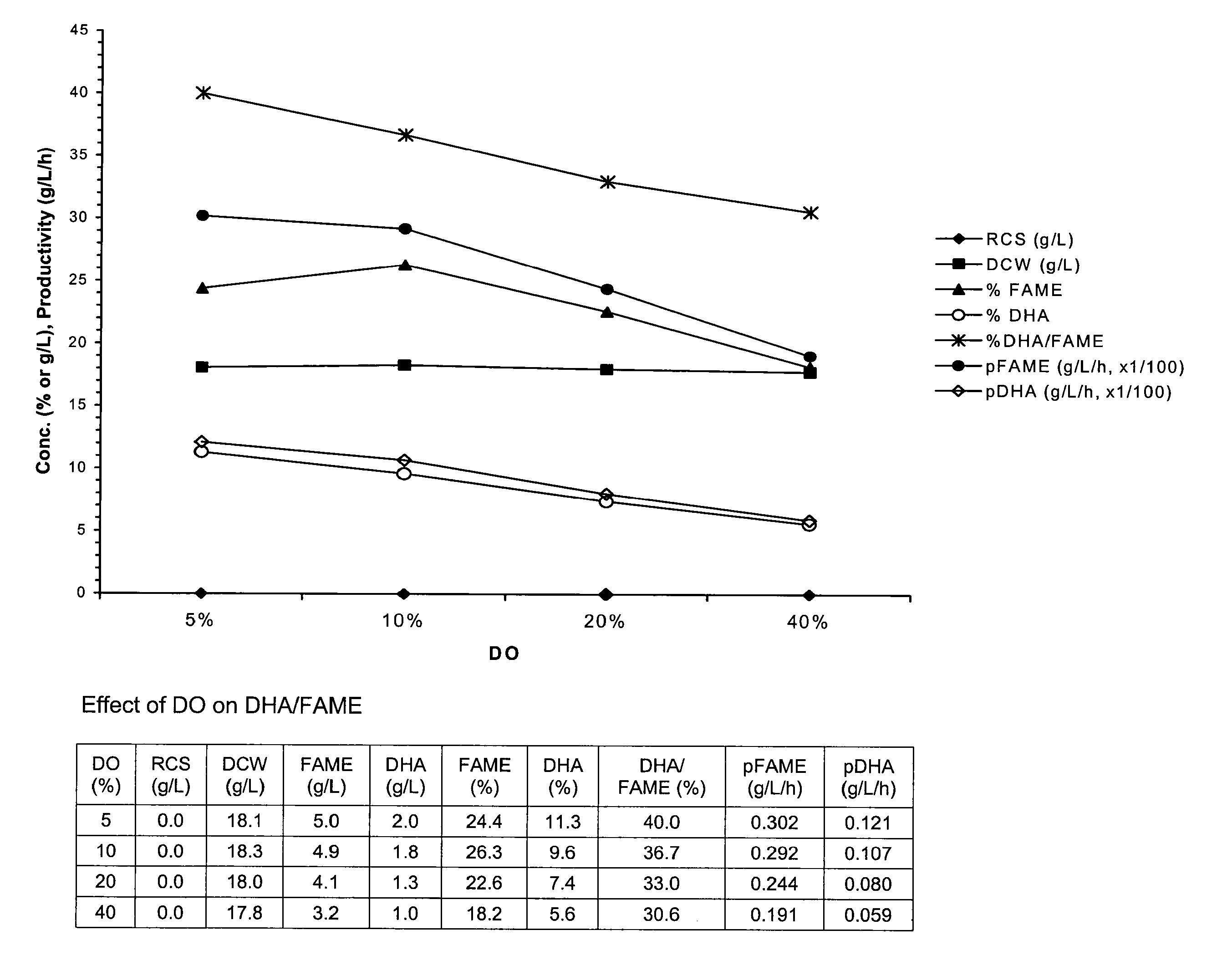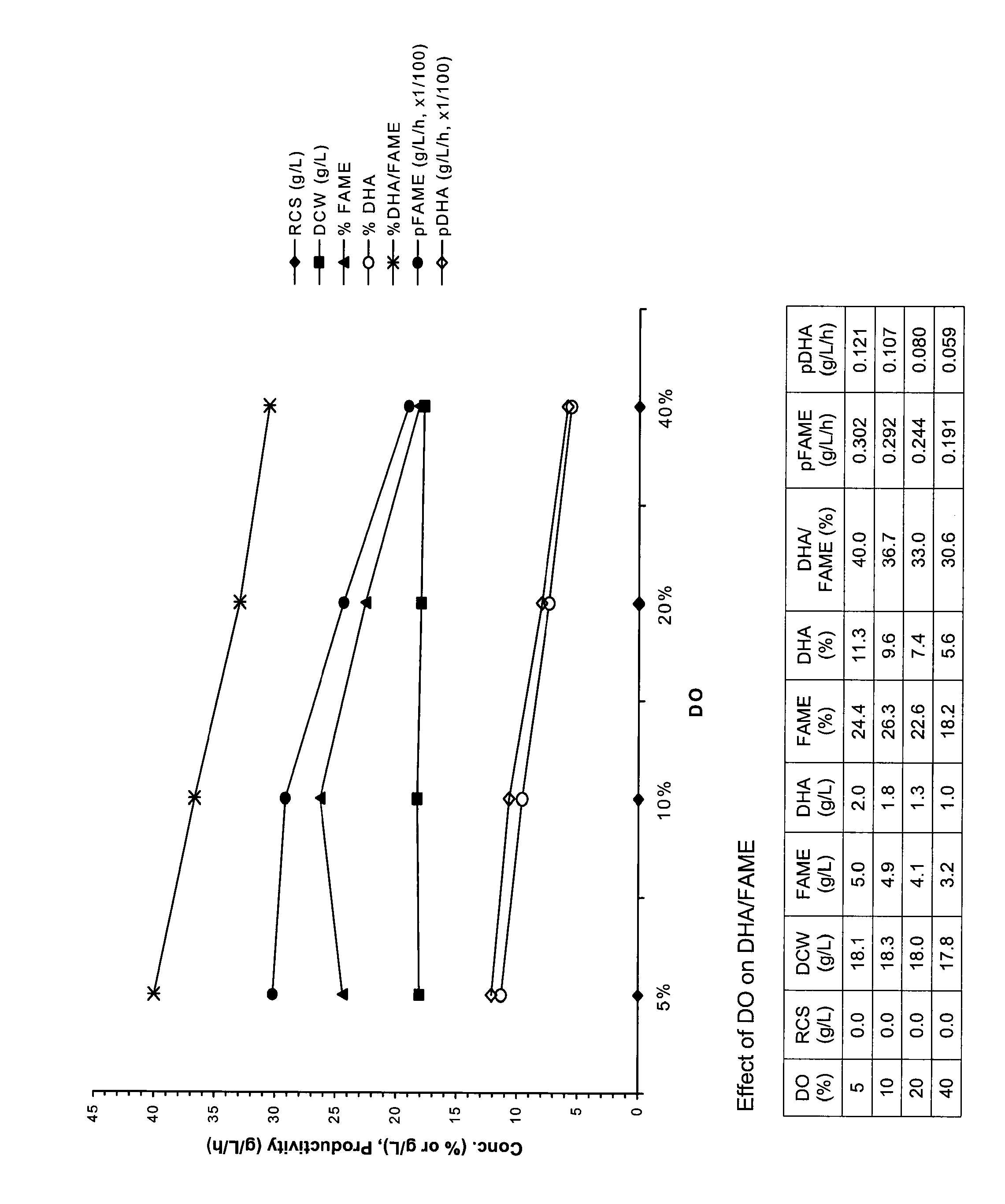Enhanced Production of Lipids Containing Polyenoic Fatty Acid by Very High Density Cultures of Eukaryotic Microbes in Fermentors
a technology high density culture, which is applied in the field of new products, can solve the problems of reducing the content reducing the productivity of polyenoic fatty acid, and maintaining high dissolved oxygen levels
- Summary
- Abstract
- Description
- Claims
- Application Information
AI Technical Summary
Benefits of technology
Problems solved by technology
Method used
Image
Examples
example 1
[0045] This example illustrates the affect of oxygen content in a fermentation medium on lipid productivity.
[0046] Fermentation results of Schizochytrium ATCC No. 20888 at various levels of dissolved oxygen content were measured. The results are shown in FIG. 1, where RCS is residual concentration of sugar, and DCW is dry-cell weight.
example 2
[0047] This example illustrates the reproducibility of processes of the present invention.
[0048] Microorganisms were produced using fermentors with a nominal working volume of 1,200 gallons. The resulting fermentation broth was concentrated and microorganisms were dried using a drum-dryer. Lipids from aliquots of the resulting microorganisms were extracted and purified to produce a refined, bleached, and deodorized oil. Approximately 3,000 ppm of d-1-α-tocopheryl acetate was added for nutritional supplementation purposes prior to analysis of the lipid.
[0049] Nine fermentations of Schizochytrium ATCC No. 20888 were run and the results are shown in Table 1. The dissolved oxygen level was about 8% during the first 24 hours and about 4% thereafter.
TABLE 1Fed-batch fermentation results for the production of DHA.AgeYield1DHAFAME2Entry(Hrs)(g / L)(%)(%)Productivity31100.3160.717.849.50.285299.8172.419.451.30.335384.7148.714.441.40.253490.2169.519.753.90.370599.0164.112.538.90.2076113.018...
example 3
[0055] This example illustrates the effect of reduced dissolved oxygen level in the fermentation medium on the productivity of microorganisms using G-tank scale.
[0056] Using the procedure described in Example 2, a 14,000 gallon nominal volume fermentation was conducted using a wild-type strain Schizochytrium, which can be obtained using isolation processes disclosed in the above mentioned U.S. Pat. Nos. 5,340,594 and 5,340,742. The dissolved oxygen level in the fermentation medium was about 8% during the first 24 hours, about 4% from the 24th hour to the 40th hour and about 0.5% from the 40th hour to the end of fermentation process. Results of this lower dissolved oxygen level in fermentation medium processes are shown in Table 3.
TABLE 314,000 gallon scale fermentation of Schizochytrium.% DHADHAAgeYield%%rel. toProductivityEntry(Hrs)(g / L)DHAFAMEFAME(g of DHA / L / hr)182.0179.321.752.441.40.474299.0183.122.355.040.50.412372.0159.3——40.9—477.0161.3——43.2—5100.0173.023.953.344.90.41361...
PUM
| Property | Measurement | Unit |
|---|---|---|
| density | aaaaa | aaaaa |
| concentration | aaaaa | aaaaa |
| density | aaaaa | aaaaa |
Abstract
Description
Claims
Application Information
 Login to View More
Login to View More - R&D
- Intellectual Property
- Life Sciences
- Materials
- Tech Scout
- Unparalleled Data Quality
- Higher Quality Content
- 60% Fewer Hallucinations
Browse by: Latest US Patents, China's latest patents, Technical Efficacy Thesaurus, Application Domain, Technology Topic, Popular Technical Reports.
© 2025 PatSnap. All rights reserved.Legal|Privacy policy|Modern Slavery Act Transparency Statement|Sitemap|About US| Contact US: help@patsnap.com


